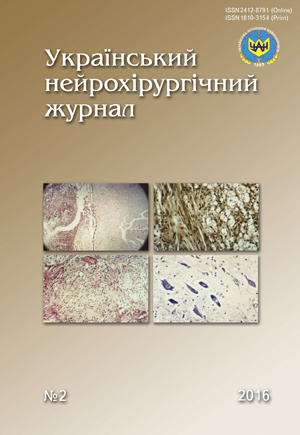Orphan and rare diseases in neurosurgery: invitation to discussion
DOI:
https://doi.org/10.25305/unj.72604Keywords:
orphan diseases, prevalence, neurosurgical treatment, multidisciplinary approachAbstract
Orphan diseases are overall a relatively new actual problem for neurosurgery because of their huge medico-social importance. This review illustrates the major characteristics of orphan diseases in neurosurgery, gives the definitions and presents statistical and epidemiological data on rare diseases encountered in neurosurgical practice. Legal framework for orphan diseases has been comparatively analysed and the list of rare diseases in neurosurgery has been made. The main problems related to patients’ access to specialized medical care, including neurosurgical treatment are discussed and their possible solutions are proposed. Based on the presented data we emphasize the need for developing a national strategy for rare diseases management, that may promote the decrease in mortality and morbidity of patients, namely with neurosurgical pathology.
References
1. EUCERD Core Recommendations on Rare Disease Patient Registration and Data Collection [Internet]. European Community Experts on Rare Diseases; 2013. [cited 2013 June 5]. Available at: http://www.eucerd.eu/wp-content/uploads/2013/06/EUCERD_Recommendations_RDRegistryDataCollection_adopted.pdf
2. Novikov PV. Pravovyye aspekty redkikh (orfannykh) zabolevaniy v Rossii i v mire [Legal Issues Relating to Rare (Orphan) Diseases — Russian and International Experience]. Medicine. 2013;4:53-73. Russian. Available at: http://www.fsmj.ru/download/04/03.pdf
3. Orphanet Report Series — List of research infrastructures useful to rare diseases in Europe. [Internet]. Orphanet Report Series; 2015 [cited 2015 January]. Available at: http://www.orpha.net/orphacom/cahiers/docs/GB/Research_Infrastructures_for_rare_diseases_in_Europe.pdf
4. US Food and Drug Administration. The Orphan Drug Act. 1983 [Internet] / US Food and Drug Administration; 2007. [cited 2007 Feb 20]. Available at: http://www.fda.gov/ForIndustry/DevelopingProductsforRareDiseasesConditions/default.htm
5. Song P, Gao J, Inagaki Y, Kokudo N, Tang W. Rare diseases, orphan drugs, and their regulation in Asia: Current status and future perspectives. Intractable & Rare Dis Res. 2012;1(1):3-9. [CrossRef] [PubMed]
6. Regulation (EC) No. 141/2000 of the European Parliament and of the Council of 16 December 1999 on Orphan Medicinal Products [Internet]. Offic. J. Europ. Communities; 2000. [cited 2000 January 22]. Available at: http://eur-lex.europa.eu/LexUriServ/LexUriServ.do?uri=OJ:L:2000:018:0001:0005:en:PDF
7. Schey C, Milanova T, Hutchings A. Estimating the budget impact of orphan medicines in Europe: 2010 — 2020. Orphanet Journal of Rare Diseases. 2011; 6:62. [CrossRef] [PubMed]
8. McGabe C, Claxton K, Tsuchiya A. Orphan drugs and the NHS: should we value rarity? BMJ. 2005; 331:1016-9. [CrossRef] [PubMed]
9. Hall AK, Carlson MR. The current status of orphan drug development in Europe and the US. Intractable & Rare Dis Res. 2014;3(1):1-7. [CrossRef]
10. European Community Register of designated orphan medicinal products. [Internet]. European Commission; 2014. [cited 2014 April 14]. Available at: http://ec.europa.eu/health/documents/community-register/html/alforphreg.htm
11. Pro vnesennya zmin do Osnov zakonodavstva Ukrainy pro okhoronu zdorovya schodo zabezpechennya profilaktyky ta likuvannya ridkisnykh (orfannykh) zakhvoryuvan’ (Vidomosti Verkhovnoyi Rady, 2014; 26:894) [On Amendments to the Basic Laws of Ukraine about public health to ensure the prevention and treatment of rare (orfannyh) diseases (Supreme Council, 2014, N26, p. 894]. [Internet]. The Verkhovna Rada of Ukraine; Act № 1213-VII from April 15, 2014; [cited 2014 April 15]. Available at: http://zakon4.rada.gov.ua/laws/show/1213-187
12. Рerechen orfannyh zabolevaniy v Rossii [The list of orphan diseases in Russia] [Internet]. Ministry of Public Health of Russian Federation; 2014 [cited 2014 May 7]. Available at: http://www.rosminzdrav.ru/documents/8048-perechen-redkih-orfannyh-zabolevaniy
13. Taruscio D, Capozzoli F, FrankAnn C. Rare diseases and orphan drugs. Ist. Super. Sanita. 2011;47(1):83-93. [CrossRef] [PubMed]
14. EUCERD Recommendations on Core Indicators for Rare Disease National Plans/Strategies [Internet] / European Community Experts on Rare Diseases; 2013. [cited 2013 June 06]. Available at: http://www.eucerd.eu/wp-content/uploads/2013/06/EUCERD_Recommendations_Indicators_adopted.pdf
15. Pro zatverdzhennya pereliku ridkisnykh (orfannykh) zakhvoryuvan’ [Internet]. The Ministry of Public Health of Ukraine; Order № 778 from October 27, 2014 (registered by The Ministry of Justice N1439/26216 on November, 13, 2014; [cited 2014 November 13]. Available at: http://zakon4.rada.gov.ua/laws/show/z1439-14
16. Orphanet Report Series – Lists of medicinal products for rare diseases in Europe. [Internet] / Orphanet Report Series; 2015 [cited 2015 July]. Available at: http://www.orpha.net/orphacom/cahiers/docs/GB/list_of_orphan_drugs_in_europe.pdf
17. Logviss K, Krievin D, Purvina S. Rare diseases and orphan drugs: Latvian story. Orphanet Journal of Rare Diseases. 2014; 9:147. [CrossRef]
18. Pro zatverdzhennya Poryadku zabezpechennya gromadyan, yaki strazhdayut’ na ridkisni (orfanni) zakhvoryuvannya, likars’kymy zasobamy ta vidpovidnymy kharchovymy produktamy dlya spetsial’nogo diyetychnogo spozhyvannya [Internet]. The Cabinet of Ministers of Ukraine. Resolution № 160 from March 31, 2015; [cited 2015 March 31]. Available at: http://zakon4.rada.gov.ua/laws/show/160-2015-п
19. Rodrıguez-Caso L, Reyes-Palomares A, Sanchez-Jimenez F, Quesada AR, Medina MA. What is known on angiogenesis-related rare diseases? A systematic review of literature. J Cell Mol Med. 2012;16(12):2872-93. [CrossRef] [PubMed]
20. Murphy SM, Puwanant A, Griggs RC, CINCH and INC Consortia of the Rare Disease Clinical Research Network. Unintended effects of orphan product designation for rare neurological diseases. Ann Neurol. 2012;2(4):481-90. [CrossRef] [PubMed]
21. Onakpoya IJ, Spencer EA, Thompson MJ, Heneghan CJ. Effectiveness, safety and costs of orphan drugs: an evidence-based review. BMJ Open. 2015;5:e007199. [CrossRef]
Downloads
Published
How to Cite
Issue
Section
License
Copyright (c) 2016 Eugene Pedachenko, Ievgenii Iarmoliuk

This work is licensed under a Creative Commons Attribution 4.0 International License.
Ukrainian Neurosurgical Journal abides by the CREATIVE COMMONS copyright rights and permissions for open access journals.
Authors, who are published in this Journal, agree to the following conditions:
1. The authors reserve the right to authorship of the work and pass the first publication right of this work to the Journal under the terms of Creative Commons Attribution License, which allows others to freely distribute the published research with the obligatory reference to the authors of the original work and the first publication of the work in this Journal.
2. The authors have the right to conclude separate supplement agreements that relate to non-exclusive work distribution in the form of which it has been published by the Journal (for example, to upload the work to the online storage of the Journal or publish it as part of a monograph), provided that the reference to the first publication of the work in this Journal is included.









